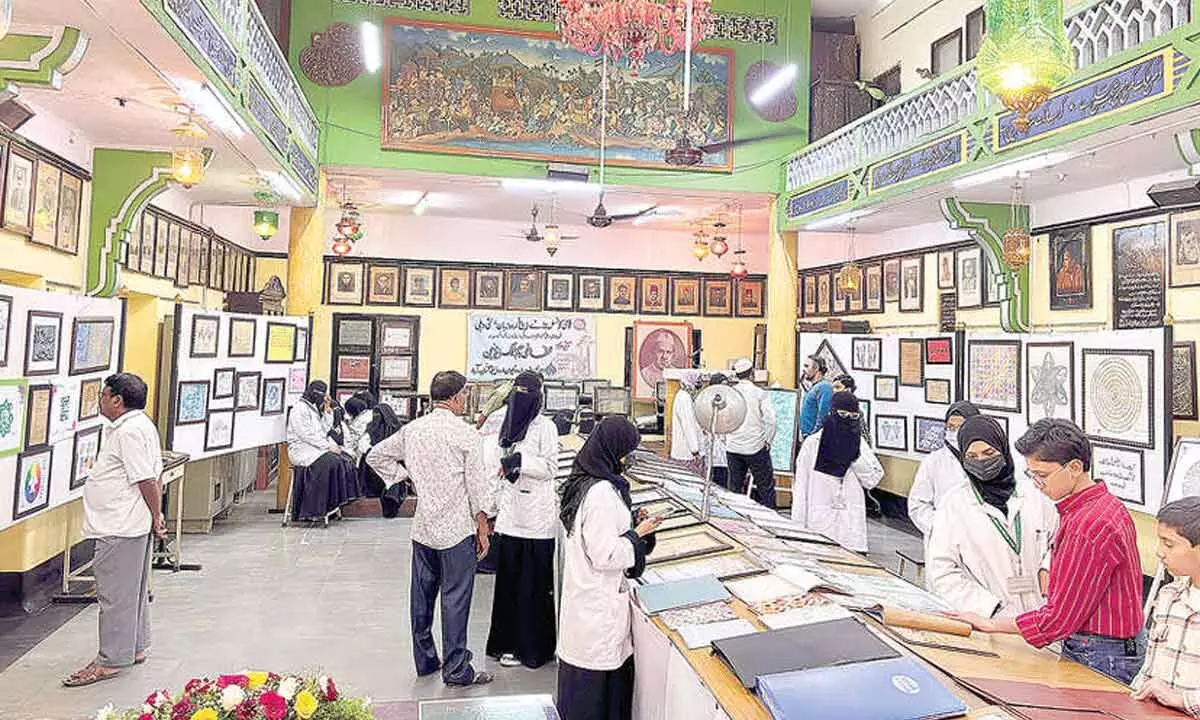Master calligrapher keeps art alive in India, abroad

Hyderabad: In an era dominated by digitalisation and artificial intelligence, where sleek fonts and automated designs have replaced handcrafted artistry, the age-old tradition of calligraphy continues to thrive in Hyderabad. This enduring art form, celebrated for its beauty and precision, owes much of its survival to individuals like Mohammed Abdul Gaffar—a master callig-rapher who has dedicated his life to preserving and promoting the craft.
For Gaffar, calligraphy is not just about creating visually appealing text. It is a blend of art (fan) and knowledge (ilm), a meticulous process where every stroke of the pen breathes life into words. “To refine this skill, proper training is essential,” he explains. “Understanding the subtleties of handwriting and mastering the techniques required to excel in this art is crucial,” he adds. Abdul Gaffar’s journey with calligraphy began during his school days when he developed a passion for the intricate art form. Over the years, this passion turned into a lifelong mission. Since the mid-1990s, Gaffar has been training aspiring calligraphers at Idara-e-Adabiyat-e-Urdu in Punjagutta, a prestigious institute established in 1931. His efforts have resulted in the training of over 10,000 students, many of whom have gone on to showcase their skills in countries like Saudi Arabia, Iran, Iraq, Yemen, Dubai, and the United Kingdom. At the heart of Gaffar’s teaching is the Nastaliq script, an essential com-ponent of Urdu calligraphy. Mastering this script is no easy feat—it re-quires months of dedicated practice, starting with correcting hand movements and developing a keen eye for detail. “Each stroke of the pen or brush tells a story,” Gaffar says, “reflecting not only the skill of the cal-ligrapher but also the rich heritage of the art itself.” Beyond being a creative pursuit, calligraphy has found practical applica-tions worldwide. According to Gaffar, calligraphers are in high demand in foreign universities, where their skills are sought to inscribe names on certificates and awards. “There’s immense respect for this craft abroad, and it continues to thrive in places where the written word is cherished,” he shares.
Gaffar’s teaching repertoire includes a variety of scripts such as English roundhand, Gothic, chancery cursive, and draughtboard styles, alongside traditional Arabic and Persian forms. In Urdu alone, he teaches a stagger-ing 108 alphabets, each with intricate variations based on their position within a word. Some of the notable styles include Khat-e-Thulth, Khat-e-Naskh, Khat-e-Nastaliq, Khat-e-Diwani, Khat-e-Riqa, and Kufi.
The calligraphy training centre at Idara-e-Adabiyat-e-Urdu is a vibrant space, bustling with students sketching designs on drawing sheets and crafting intricate patterns using traditional reed pens, known as khalam. The institute offers a two-year diploma course in Calligraphy and Graphic Design under the sponsorship of the National Council for Promotion of Urdu Language (NCPUL), ensuring that this art form is passed on to the next generation.
Students showcase their skills on unique canvases, including eggshells, rice grains, pistachio shells, and lentils—often using 24-carat gold for embellishment. Remarkably, the art form has attracted non-Urdu speak-ers, underscoring its universal appeal.
Despite its rich tradition, Urdu calligraphy faces challenges in India. While the government proposed introducing calligraphy into school cur-riculums (as per GO 313 issued in 1990), the plan has seen little progress due to a lack of instructors. However, initiatives like those led by Gaffar offer a glimmer of hope.
For Gaffar, calligraphy is more than a profession; it’s a meditative experi-ence, a journey of self-expression that connects the artist to their inner self. Through workshops and demonstrations, he invites people of all ag-es to experience this joy firsthand.


